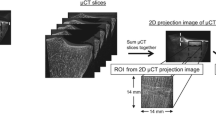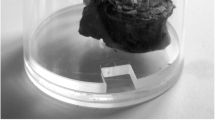Abstract
The high importance of intracortical porosity for mechanical strength of cortical bone has been established. The contribution of other parameters of microstructure such as osteon dimensions for strength is in discussion. The aim of this study was to evaluate the predictive value of microcomputed tomography (µCT) for porosity and other microstructural parameters of cortical bone in cortical bone biopsies. Femoral cortical bone specimens from the middiaphysis of 24 patients were harvested during the procedure of total hip replacement at the location where normally one hole (Ø 4.5 mm) for the relief of the intramedullary pressure is placed.In vitro intracortical porosity and bone mineral density (BMD) measurements by µCT were compared with structural parameters assessed in histological sections of the same specimens. A strong correlation was found between intracortical porosity measured by µCT and histological porosity (r=0.95,P<0.0001). Porosity measured by µCT was also a strong predictor for other parameters describing dimensions of porous structures. BMD−1 was associated with osteonal area (r=−0.76,P<0.0001). We consider the measurement of porosity by µCT as a very potent procedure for assessing intracortical porosity and parameters related to porous structures of cortical bone nondestructivelyin vitro.
Similar content being viewed by others
References
Spadaro JA, Werner FW, Brenner RA, Fortino MD, Fay LA, Edwards WT (1994) Cortical and trabecular bone contribute strength to the osteopenic distal radius. J Orthop Res 12:211–218
Augat P, Margevicius K, Simon J, Wolf S, Suger G, Claes L (1998) Local tissue properties in bone healing: influence of size and stability of the osteotomy gap. J Orthop Res 16:475–481
Augat P, Reeb H, Claes LE (1996) Prediction of fracture load at different skeletal sites by geometric properties of the cortical shell. J Bone Miner Res 11:1356–1363
Louis O, Boulpaep F, Willnecker J, Van-den-Winkel P, Osteaux M (1995) Cortical mineral content of the radius assessed by peripheral QCT predicts compressive strength on biomechanical testing. Bone 16:375–379
Snyder SM, Schneider E (1991) Estimation of mechanical properties of cortical bone by computed tomography J Orthop Res 9:422–431
Stromsoe K, Kok WL, Hoiseth A, Alho A (1993) Holding power of the 4.5 mm AO/ASIF cortex screw in cortical bone in relation to bone mineral. Injury 24:656–659
Yeni YN, Brown CU, Wang Z, Norman TL (1997) The influence of bone morphology on fracture toughness of the human femur and tibia. Bone 21:453–459
Barth RW, Williams JL, Kaplan FS (1992) Osteon morphometry in females with femoral neck fractures. Clin Orthop: 178–186
Carter DR, Hayes WC (1977) The compressive behavior of bone as a two-phase porous structure. J Bone Joint Surg Am 59:954–962
Martin RB, Ishida J (1989) The relative effects of collagen fiber orientation, porosity, density, and mineralization on bone strength. J Biomech 22:419–426
Schaffler MB, Burr DB (1988) Stiffness of compact bone: effects of porosity and density. J Biomech 21:13–16
Currey JD (1988) The effect of porosity and mineral content on the Young’s modulus of elasticity of compact bone. J Biomech 21:131–139
Delling G, Hahn M, Bonse U, Busch F, Gunnewig O, Beckmann F, Uebbing H, Graeff W (1995) New possibilities for structural analysis of bone biopsies using microcomputer tomography (µCT). Pathologe 16:342–347
Feldkamp LA, Goldstein SA, Parfitt AM, Jesion G, Kleerekoper M (1989) The direct examination of three-dimensional bone architecture in vitro by computed tomography. J Bone Miner Res 4:3–11
Goldstein SA, Goulet R, McCubbrey D (1993) Measurement and significance of three-dimensional architecture to the mechanical integrity of trabecular bone. Calcif Tissue Int 53:127–132
Goulet RW, Goldstein SA, Ciarelli MJ, Kuhn JL, Brown MB, Feldkamp LA (1994) The relationship between the structural and orthogonal compressive properties of trabecular bone. J Biomech 27:375–389
Black J, Mattson R, Korostoff E (1974) Haversian osteons: size, distribution, internal structure and orientation. J Biomed Mater Res 8:299
Currey JD (1964) Some effects of ageing in human haversian systems. J Anat 98:69
Evans FB (1976) Mechanical properties and histology of cortical bone from younger and older men. Anat Rec 185:1
Jowsey J (1960) Age changes in human cortical bone. Clin Orthop 17:210
Kelsey JL, Hoffman S (1987) Risk factors for hip fractures (editorial). N Engl J Med 316:404
Martin RB, Pickett JC, Zinaich S (1980) Studies of skeletal remodeling in aging men. Clin Orthop 149:268–282
Sietsema WK (1995) Animal models of cortical porosity. Bone 17:297S-305S
McCladen RW, McGeough JA, Barker MB, Court Brown CM (1993) Age-related changes in the tensile properties of cortical bone. The relative importance of changes in porosity, mineralization, and microstructure. J Bone Joint Surg Am 75:1193–1205
Brockstedt H, Kassem M, Eriksen EF, Mosekilde L, Melsen F (1993) Age- and sex-related changes in iliac cortical bone mass and remodeling. Bone 14:681–691
Squillante RG, Williams JL (1993) Videodensitometry of osteons in females with femoral neck fractures. Calcif Tissue Int 52:273–277
Evans FB, Bang S (1967) Differences and relationships between the physical properties and the microscopic structure of human femoral, tibial and cortical bone. Am J Anat 120:79
Yeni YN, Brown CU, Norman TL (1998) Influence of bone composition and apparent density on fracture toughness of the human femur and tibia. Bone 22:79–84
Author information
Authors and Affiliations
Rights and permissions
About this article
Cite this article
Wachter, N.J., Augat, P., Krischak, G.D. et al. Prediction of cortical bone porosityIn Vitro by microcomputed tomography. Calcif Tissue Int 68, 38–42 (2001). https://doi.org/10.1007/BF02685001
Received:
Accepted:
Published:
Issue Date:
DOI: https://doi.org/10.1007/BF02685001




